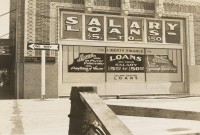- Home
- Business Processes
- Industry Knowledge
- Aerospace Industry
- Automotive Industry
- Banking Domain
- BFSI Industry
- Consumer/ FMCG Industry
- Chemicals Industry
- Engineering & Construction
- Energy Industry
- Education Domain
- Finance Domain
- Hospitality Domain
- Healthcare Industry
- Insurance Domain
- Retail Industry
- Travel and Tourism Domain
- Telecom Industry
- Leadership Skills
- eLearning
- Home
- Industry Knowledge
- Banking Domain
- History of Banking: The Gold Standard & Fractional Reserve Banking
History of Banking: The Gold Standard & Fractional Reserve Banking
Gold has always been considered as a safe economic investment and treated like a currency. All of the economically advanced countries of the world were on the gold standard for a relatively brief time. Under a gold standard, the value of a unit of currency, such as a dollar, is defined in terms of a fixed weight of gold and banknotes or other paper money are convertible into gold accordingly. Explore the fascinating history of the gold standard through the lens of history and also learn why banks hold back a certain fraction of deposits as reserves.
Under a gold standard, the value of a unit of currency, such as a dollar, is defined in terms of a fixed weight of gold and bank notes or other paper money are convertible into gold accordingly. Although the monetary systems of individual countries have been based on the gold standard at times, all the economically advanced countries of the world were on the gold standard for a relatively brief time—roughly from 1870 to 1914, sometimes called the period of the classic gold standard.
The Gold Coinage
 The coinage of gold dates back to 700BC in the Mediterranean world, and it continued during the Roman Empire. Gold coinage disappeared from Europe during the middle ages, but during the thirteenth century Florence popularized gold coinage among Italian cities. The influence of the Italian cities seems to have brought the practice of gold coinage to England, where it caught on, particularly after the mid-fourteenth century. Charles II introduced a new English gold coin called a guinea in 1663. From England gold coinage then spread to the rest of Western Europe.
The coinage of gold dates back to 700BC in the Mediterranean world, and it continued during the Roman Empire. Gold coinage disappeared from Europe during the middle ages, but during the thirteenth century Florence popularized gold coinage among Italian cities. The influence of the Italian cities seems to have brought the practice of gold coinage to England, where it caught on, particularly after the mid-fourteenth century. Charles II introduced a new English gold coin called a guinea in 1663. From England gold coinage then spread to the rest of Western Europe.
The Gold Standard – The Beginning
 At the opening of the nineteenth century, no European country was on a gold standard or had developed a gold standard system. England and other countries coined both gold and silver and set the conversion ratio at which gold could be exchange for silver. England was still officially on a sterling silver standard, but in the eighteenth century the English government overvalued gold relative to silver, causing an outflow of silver and an inflow of gold and lifting gold to a position of preeminence in England’s monetary system. In normal times banks redeemed paper money out of reserves of specie (precious metal coinage), but during the wars with revolutionary France and Napoleon, the Bank of England suspended the redemption of its bank notes in specie. After Napoleon’s defeat in 1815, Parliament turned its attention to the resumption of specie payments, and passed the Coinage Act of 1816. This act placed England definitely on the gold standard, while the rest of Europe remained on a silver or bimetallic standard. In 1819 Parliament passed the Act for the Resumption of Cash Payments, which provided for the resumption by 1823 of the convertibility of Bank of England bank notes into gold specie. By 1821 the gold standard was in full operation in England. Except for England, most countries operated bimetallic systems until the 1870s. Under a bimetallic system both gold and silver coins circulated as legal-tender mediums.
At the opening of the nineteenth century, no European country was on a gold standard or had developed a gold standard system. England and other countries coined both gold and silver and set the conversion ratio at which gold could be exchange for silver. England was still officially on a sterling silver standard, but in the eighteenth century the English government overvalued gold relative to silver, causing an outflow of silver and an inflow of gold and lifting gold to a position of preeminence in England’s monetary system. In normal times banks redeemed paper money out of reserves of specie (precious metal coinage), but during the wars with revolutionary France and Napoleon, the Bank of England suspended the redemption of its bank notes in specie. After Napoleon’s defeat in 1815, Parliament turned its attention to the resumption of specie payments, and passed the Coinage Act of 1816. This act placed England definitely on the gold standard, while the rest of Europe remained on a silver or bimetallic standard. In 1819 Parliament passed the Act for the Resumption of Cash Payments, which provided for the resumption by 1823 of the convertibility of Bank of England bank notes into gold specie. By 1821 the gold standard was in full operation in England. Except for England, most countries operated bimetallic systems until the 1870s. Under a bimetallic system both gold and silver coins circulated as legal-tender mediums.
 The English banking system evolved toward the use of Bank of England bank notes as reserves for commercial banks, and the Bank of England became the custodian of the country’s gold reserves. The Bank of England learned to protect its gold reserves by adjustments in interest rates, using its bank rate and open market operations to raise interest rates and stem an outflow of gold. Higher interest rates attracted foreign capital that could be converted into gold, and lower interest rates had the opposite effect. Low interest rates were the natural results of a gold inflow.
The English banking system evolved toward the use of Bank of England bank notes as reserves for commercial banks, and the Bank of England became the custodian of the country’s gold reserves. The Bank of England learned to protect its gold reserves by adjustments in interest rates, using its bank rate and open market operations to raise interest rates and stem an outflow of gold. Higher interest rates attracted foreign capital that could be converted into gold, and lower interest rates had the opposite effect. Low interest rates were the natural results of a gold inflow.
Gold Standard – The Golden Age
 By the end of the 1870s France, Germany, Holland, Russia, Austro-Hungary, and the Scandinavian countries were on the gold standard. The bimetallic system became awkward because official conversion ratios between gold and silver often differed from the ratio that existed in the precious metals market. Gold discoveries in California and Australia flooded markets for precious metals and gold began to replace silver as the circulating medium in France and other European countries. The wars and revolutions of the mid-nineteenth century again forced governments into issuing inconvertible paper money. Governments often restored convertibility by establishing the gold standard. If the gold standard had a golden age, it was between 1870 and 1914, when it acted as a brake on the issuance of paper money. If prices in Country A rose faster than prices in Country B, residents of A would start buying more goods from Country B. Gold would flow out of Country A into Country B, increasing the money supply in Country B and decreasing it in Country A. These money supply changes lowered prices in Country A and raised prices in Country B. These adjustments restored equilibrium, eliminating the need for further gold flows, and stabilizing prices at an equilibrium level.
By the end of the 1870s France, Germany, Holland, Russia, Austro-Hungary, and the Scandinavian countries were on the gold standard. The bimetallic system became awkward because official conversion ratios between gold and silver often differed from the ratio that existed in the precious metals market. Gold discoveries in California and Australia flooded markets for precious metals and gold began to replace silver as the circulating medium in France and other European countries. The wars and revolutions of the mid-nineteenth century again forced governments into issuing inconvertible paper money. Governments often restored convertibility by establishing the gold standard. If the gold standard had a golden age, it was between 1870 and 1914, when it acted as a brake on the issuance of paper money. If prices in Country A rose faster than prices in Country B, residents of A would start buying more goods from Country B. Gold would flow out of Country A into Country B, increasing the money supply in Country B and decreasing it in Country A. These money supply changes lowered prices in Country A and raised prices in Country B. These adjustments restored equilibrium, eliminating the need for further gold flows, and stabilizing prices at an equilibrium level.
The End of Gold Standard
 World War I brought an end to the gold standard, partly because the export of gold was not feasible after 1914, and partly because governments wanted the freedom to print extra paper money to finance the war effort. The end of World War I set the stage for an international scramble for gold as countries tried to reestablish national gold standards. Britain and France kept their currencies overvalued in terms of gold, hurting the competitiveness of their export industries in foreign markets and causing recessions at home. The economic debacle of the 1930s spelled the end of the gold standard for domestic economies. Governments wanted the freedom to follow cheap money policies in the face of severe depression. The United States Gold Reserve Act of 1934 authorized the United States Treasury to buy and sell gold at a rate of $35 per ounce of gold in order stabilize the value of the dollar in foreign exchange markets. This legislation laid the foundation for the world to return to the gold standard for international transactions after World War II. The value of the dollar was fixed in gold, and the value of other currencies was fixed in dollars. The system only became fully operational after World War II, when most countries lifted bans on the exportation of gold. This gold exchange standard for international transactions remained in effect until 1971.
World War I brought an end to the gold standard, partly because the export of gold was not feasible after 1914, and partly because governments wanted the freedom to print extra paper money to finance the war effort. The end of World War I set the stage for an international scramble for gold as countries tried to reestablish national gold standards. Britain and France kept their currencies overvalued in terms of gold, hurting the competitiveness of their export industries in foreign markets and causing recessions at home. The economic debacle of the 1930s spelled the end of the gold standard for domestic economies. Governments wanted the freedom to follow cheap money policies in the face of severe depression. The United States Gold Reserve Act of 1934 authorized the United States Treasury to buy and sell gold at a rate of $35 per ounce of gold in order stabilize the value of the dollar in foreign exchange markets. This legislation laid the foundation for the world to return to the gold standard for international transactions after World War II. The value of the dollar was fixed in gold, and the value of other currencies was fixed in dollars. The system only became fully operational after World War II, when most countries lifted bans on the exportation of gold. This gold exchange standard for international transactions remained in effect until 1971.
In 1971 the United States, after experiments with devaluation, suspended the conversion of dollars into gold as the only means of stemming a major outflow of gold. Abandonment of the gold standard preceded the strong worldwide surge of inflation in the late 1970s, and critics attributed the inflation to the loss of discipline provided by the gold standard. The inflation of the 1970s can be attributed to many factors, such as shortages of important commodities, powerful unions, monopolistic pricing, and undisciplined monetary growth.
Gold Standard becomes History
 Most economists see the gold standard as a relic of history. In the absence of the gold standard, governments and monetary authorities enjoy more flexibility to adjust domestic money stocks to meet the needs of domestic economies. The experience of the 1980s and 1990s suggests that countries can control inflation without the gold standard. The Swedish currency was until 1931 backed by gold and the paper-certificates could be exchanged for gold coins. The bank was obligated until 1975 by the Swedish constitution to exchange the paper-certificates for gold, but in 1931 a specialized temporary law was written to free the bank from this obligation. This law was renewed every year until the new constitution was ratified 1975 which split the bank from the government into a stand-alone organization not obligated to exchange notes for gold.
Most economists see the gold standard as a relic of history. In the absence of the gold standard, governments and monetary authorities enjoy more flexibility to adjust domestic money stocks to meet the needs of domestic economies. The experience of the 1980s and 1990s suggests that countries can control inflation without the gold standard. The Swedish currency was until 1931 backed by gold and the paper-certificates could be exchanged for gold coins. The bank was obligated until 1975 by the Swedish constitution to exchange the paper-certificates for gold, but in 1931 a specialized temporary law was written to free the bank from this obligation. This law was renewed every year until the new constitution was ratified 1975 which split the bank from the government into a stand-alone organization not obligated to exchange notes for gold.
Fractional Reserve Banking
 The principle of fractional reserve banking lies at the heart of the modern commercial banking system. During a given period of time a bank will receive fresh deposits while existing deposits are withdrawn. Normally the fresh deposits and the withdrawn deposits cancel each other out. Despite daily deposits and withdrawals, a bank maintains an average level of deposits that represents funds the bank can largely keep loaned out. For safety banks hold back a certain fraction of deposits, called reserves (thus fractional reserve banking), to cover themselves over periods of time when withdrawn deposits exceed fresh deposits. Because these reserves earn no interest, banks are tempted to cut the margin of reserves a bit thin. If adequate, these reserves enable a bank to weather a crisis of confidence when masses of people suddenly withdraw deposits out of fear.
The principle of fractional reserve banking lies at the heart of the modern commercial banking system. During a given period of time a bank will receive fresh deposits while existing deposits are withdrawn. Normally the fresh deposits and the withdrawn deposits cancel each other out. Despite daily deposits and withdrawals, a bank maintains an average level of deposits that represents funds the bank can largely keep loaned out. For safety banks hold back a certain fraction of deposits, called reserves (thus fractional reserve banking), to cover themselves over periods of time when withdrawn deposits exceed fresh deposits. Because these reserves earn no interest, banks are tempted to cut the margin of reserves a bit thin. If adequate, these reserves enable a bank to weather a crisis of confidence when masses of people suddenly withdraw deposits out of fear.
Banking Domain Knowledge - Resources
Related Links
You May Also Like
-
Definition of Bank: Meaning of the term Bank and the Business of Banking
What do we mean by the word bank? How did the word bank originate? What is the most simple and concise definition of a bank that explains the fundamentals of the banking process? Does the definition of banking vary from country to country? What are the key differentiators between any other business and a Bank? Get answers to all these questions and explore the basics of bank and banking as an industry.
-
History of Banking: Evolution of Banking as an Industry
Banking is one of the oldest industries and banking in the form that we know of began at about 2000BC of the ancient world. It started with merchants making grain loans to farmers and traders while carrying goods between cities. Since then, the banking industry has evolved from a simplistic barter system and gift economies of earlier times to modern complex, globalized, technology-driven, and internet-based e-banking model. In this article, we will take you through the major events and developments in the history of the banking industry.
-
History of Banking: Famous Banks from the Past
Seven hundred years ago a bank was established in Venice, which made transactions resembling modern banking. In 1407, another bank was founded in Italy under the name of Banco di San Giorgio which was one of the oldest chartered banks in Europe. Sveriges Riksbank (Riksbanken), is the central bank of Sweden and the world's oldest central bank. The Bank of England is the second oldest central bank in the world, and most modern central banks have been based on that model. Let us explore some interesting events as we learn more about these early banking institutions.
-
History of Banking: The Gold Standard & Fractional Reserve Banking
Gold has always been considered as a safe economic investment and treated like a currency. All of the economically advanced countries of the world were on the gold standard for a relatively brief time. Under a gold standard, the value of a unit of currency, such as a dollar, is defined in terms of a fixed weight of gold and banknotes or other paper money are convertible into gold accordingly. Explore the fascinating history of the gold standard through the lens of history and also learn why banks hold back a certain fraction of deposits as reserves.
-
Overview of Banking Industry: The Industry Basics
Banks play a key role in the entire financial system by mobilizing deposits from households spread across the nation and making these funds available for investment, either by lending or buying securities. Today the banking industry has become an integral part of any nation’s economic progress and is critical for the financial wellbeing of individuals, businesses, nations, and the entire globe. In this article, we will provide an overview of key industry concepts, main sectors, and key aspects of the banking industry’s business model and trends.
-
Banking Sector, Segments & It's Classifications
The banking industry players deal in a variety of products from savings accounts to loans and mortgages, offer various services from check cashing to underwriting, caters to different types of customers from individuals to large corporates, serve diverse geographies from rural villages to cross-border operations. Thus the banking industry is made up of several types of banks, with their own objectives, roles, and functions. In this article, we will explore the various sectors, segments, and classifications of banking based on parameters like products, customers, types, etc.
-
Type of Banks: Different Types of Banks in India & their Functions
This article explains the banking structure in India and how different banks are classified as per RBI Norms. The Indian banking industry has been divided into two parts, organized and unorganized sectors. The organized sector consists of Reserve Bank of India, Commercial Banks and Co-operative Banks, and Specialized Financial Institutions (IDBI, ICICI, IFC, etc.). The unorganized sector, which is not homogeneous, is largely made up of money lenders and indigenous bankers. Learn what we mean by nationalized banks, scheduled banks, public sector banks, private banks, and foreign banks.
-
Types of Banks: Different Banks & their Classifications (Global)
The banking industry caters to various sections of society thus the focus of banking becomes varied, catering to the diverse needs of clients through different products, services, and methods. To meet this, we need distinctive kinds of banks addressing complex business & social needs. In this article, we will explain various types of banking institutions ranging from retail banks, commercial banks, co-operative banks, investment banks, central banks to various other types of specialized banks.
-
Banking Operations: Understanding Various Transactions & Activities
Banks perform a variety of operations ranging from basic or primary functions like day to day transactions at a branch to others that maybe the agency or general utility services in nature. The transactions that are incidental to revenue/sales or sustaining the business are an important element of the banking industry value chain. In this article, we will look at the key operations performed in the course of banking.
-
Banking Industry Business Model - Understanding How the Banking System Works
Banks are commercial profitable institutions and need to increase their business, grow their revenue, and provide returns to their owners. Unlike other stores and shops, banks are providing services rather than selling their products. Learn how banks get their funds and how they make money on services. Read more to learn how the banks earn their profit!
Explore Our Free Training Articles or
Sign Up to Start With Our eLearning Courses

About Us
Learning
© 2023 TechnoFunc, All Rights Reserved










